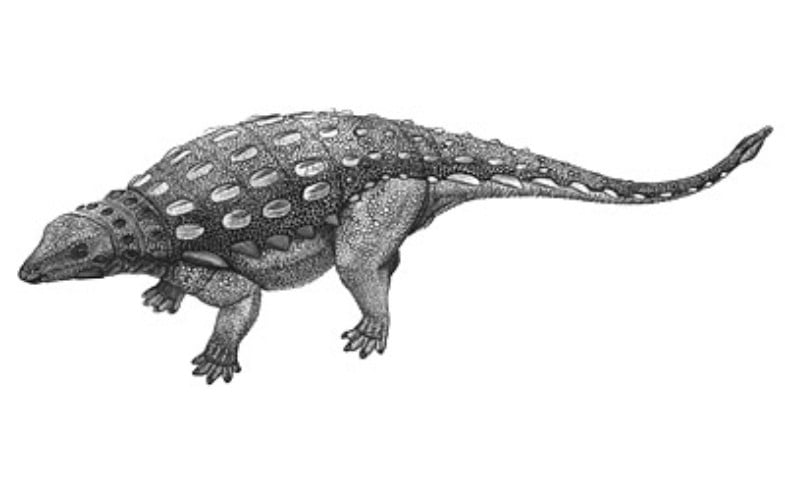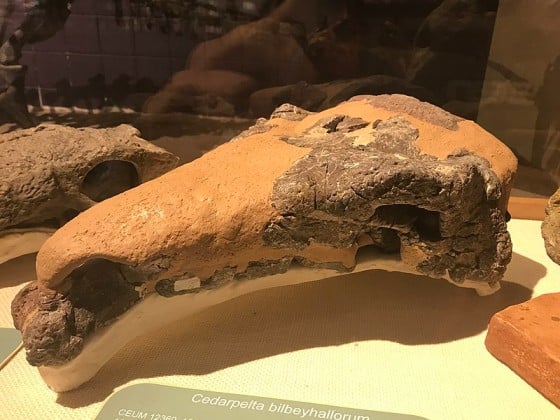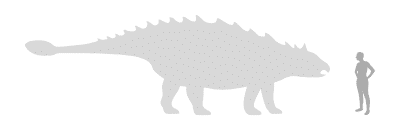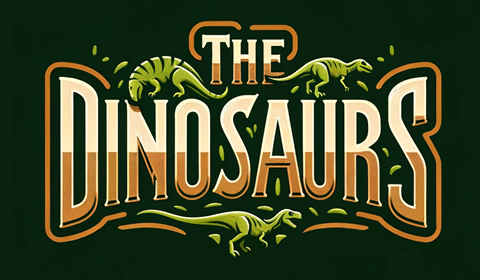Cedarpelta bilbeyhallorum was an impressive ankylosaur dinosaur which lived in modern day Utah, USA during during the Late Cretaceous Period. I am calling it impressive since some scholars have argued it might have been even larger than Ankylosaurus, at around twentyfive feet.
Key Facts
| Cedarpelta pronunciation | see-dar-pel-tuh |
| Meaning of name | Cedar (Mountain) shield |
| Group | Ankylosauria |
| Type Species | Cedarpelta bilbeyhallorum |
| Diet | Herbivore |
| When it Lived | 98 – 93 MYA |
| Period | Late Cretaceous |
| Epoch | Aptian to Albian |
| Length | 23-28.0 ft |
| Height | 6.0 ft |
| Weight | 5-6 tons |
| Mobility | Moved on all four |
| First Discovery | 1998 by Evan Hall and Sue Ann Bilbey |
| Location of first find | Utah, USA |
| Described by | 2001 by Kenneth Carpenter, James Kirkland, Don Burge, and John Bird |
| Holotype | CEUM 12360 |
Cedarpelta Origins, Taxonomy and Timeline

Cedarpelta gets its name from the location it was discovered, the Cedar Mountain Formtion in Utah, USA. The ending, -pelta is derived from the Greek ‘pelte’ which means shield, and is a nod to a possible unique formation it had of its ostederm (armor/scales) plates.
This name is fitting for a dinosaur belonging to the Ankylosauria group, known for their armored bodies. Its type species is Cedarpelta bilbeyhallorum, named in honor of paleontologists Sue Ann Bilbey and Evan Hall who made the first discovery.
The Cedarpelta’s timeline is a fascinating journey through Earth’s history. It was originally believed to have lived at the very end of the Early Cretaceous, around 105-100 MYA. However, more recent dating of the rock layer it was found in places the age to somewhere between 98-93 MYA.
This places the age of the remains at the beginning of the Late Cretaceous Period. Rather than at the end of the Early Cretaceous period as was previously believed. Placing it in a time of significant evolutionary development among dinosaurs. This period was characterized by a warm climate, high sea levels, and the emergence of flowering plants, which likely played a role in this herbivorous dinosaur’s diet.
Discovery & Fossil Evidence
The first fossils of this dinosaur were found in Utah, USA in 1998 by Evan Hall and Sue Ann Bilbey. The fossils were well-preserved and provided a wealth of information about this dinosaur’s physical characteristics and lifestyle.

An additional discovery of Cedarpelta remains were made in 2008 in the Price River II Quarry, also in Utah, USA. The subsequent find have helped to paint a more complete picture of this dinosaur and allowed scientists to piece together its physical characteristics, diet, and behavior.
The fossils are a testament to the creature’s unique physical characteristics. The well-preserved remains have allowed scientists to study its distinctive body armor, its herbivorous diet, and its movement on all four legs. These findings have contributed significantly to our understanding of the Ankylosauria group and the Early Cretaceous period.
Cedarpelta Size and Description
It was a dinosaur of considerable size, with a body built for survival. Its most distinctive feature was its body armor so typical for the ankylosaur dinosaurs. This armor was made up of bony plates embedded in the skin and provided it with a formidable defense against predators.
Its head was small in comparison to its body with a beak-like mouth that was well-suited for its herbivore diet. Its neck was short and strong to support the weight of its armored head. The vertebrae were robust, providing a sturdy framework for its armored body.
Its limbs were short and strong, built for supporting its heavy body and moving on all four legs. Its tail was also armored and provided an additional line of defense against predators. The skin of Cedarpelt was likely tough and thick to further aid in protection against possible predators in the Late Cretaceous period.
Size and Weight of Type Species

The size and weight are subjects of ongoing research. As with many dinosaurs, the exact measurements are difficult to determine and there are slightly different estimations.
Different estimates place Cedarpeltas length at somewhere between 23 and 28 feet, weighing around 5-6 US tons, or 11.000-13.000 lbs. Its height was likely somewhere in the range 7-9 feet.
Despite the uncertainties, one thing is clear: the Cedarpelta was a substantial dino built for survival in the challenging ecosystem it lived in during the Late Cretaceous period. Its size, armored body, and herbivorous diet make it a fascinating subject of study for paleontologists.
The Cedarpelta in its Natural Habitat
It lived during the Late Cretaceous period, a time when the Earth was undergoing significant geological and biological changes. One of these changes was the position of the continents, which were slowly moving to their modern positions. North America was split into two and this dinosaur could be found on the western half—known as Laramidia. The climate was warm, sea levels were high, and flowering plants were beginning to emerge. These conditions would have shaped the environments in which the Cedarpelta lived and influenced its diet and behavior.
As an herbivore, it would have consumed a variety of plant material. Its beak-like mouth and strong jaw muscles would have allowed it to consume leaves, stems, and possibly even wood. This diet would have influenced the types of vegetation that thrived in the areas where it lived, shaping the landscape and ecosystem.
Its movement on all four legs would have allowed it to navigate the diverse terrains of the Late Cretaceous. This form of locomotion, combined with its armored body, would have made this herbivore a strong presence in its environment. Likely influencing the behavior of other animals in its environment, shaping predator-prey relationships and influencing the overall dynamics of the ecosystem.
Interesting Points about Cedarpelta
- Its name, which translates to “Cedar (Mountain) shield”, is a nod to the location of its discovery and its distinctive body armor.
- It is part of the Ankylosauria group, which are known for their armored bodies and herbivorous diet.
- This herbivorous dinosaur lived during the Late Cretaceous period, a time of significant evolutionary development among dinosaurs.
- It moved on all four legs, a form of locomotion that provided it with stability and strength.
- Its herbivorous diet likely played a role in shaping the environments in which it lived by influencing the types of vegetation that thrived in these areas.
Contemporary Dinosaurs
North America is a place where a wide range of Cretaceous dinosaurs can be found. One of these Laramidian dinosaurs is the Cedarpelta. However, it shared this environment with, among others, the Cedarosaurus, Gastonia, and Deinonychus, all of which contributed to the intricate dance of existence in their unique ways.
The Cedarosaurus, a fellow herbivore, likely shared feeding grounds with the Cedarpelta. Their coexistence might very well have been a harmonious one. Indeed, both dinosaurs might have been peacefully grazing on the lush vegetation of their shared habitat. However, the Gastonia, with its heavily armored body, presents a stark contrast. This dinosaur, built like a living fortress, might have been a fearsome sight for the Cedarpelta. Despite their differences in defense strategies, these herbivores shared a common challenge: evading predators.
Enter the Deinonychus—a swift and agile predator. This carnivorous dinosaur might have posed a significant threat to the Cedarpelta and its herbivorous contemporaries. The Deinonychus brings a sense of danger and excitement to our prehistoric scene. This is especially so with its sharp claws and keen hunting instincts.
It’s fascinating to imagine how the Cedarpelta might have navigated this complex ecosystem. Coexisting as it was with dinosaurs as diverse as the peaceful Cedarosaurus, the armored Gastonia, and the predatory Deinonychus. This dynamic interplay of species underscores the richness and diversity of life in the age of dinosaurs.
List of All Dinosaurs
We have created a list of all dinosaurs we have covered here, sorted across the seven main groups of dinosaurs. We also include information about their type of diet, (omnivore, herbivore or carnivore) and the time they lived.
Frequently Asked Questions
The name translates to “Cedar (Mountain) shield”, a nod to the location of its discovery and its distinctive body armor.
It belonged to the Ankylosauria group–a group known for their armored bodies and herbivorous diet.
It lived during the Early Cretaceous period. Specifically during the Aptian to Albian epochs, around 125 to 100.5 million years ago.
It moved on all four legs, a form of locomotion that provided it with stability and strength.
As an herbivore, it would have consumed a variety of plant material, including leaves, stems, and possibly even wood.
Sources
- https://www.researchgate.net/publication/284800280_Disarticulated_skull_of_a_new_primitive_ankylosaurid_from_the_Lower_Cretaceous_of_eastern_Utah
- https://onlinelibrary.wiley.com/doi/abs/10.1111/j.1755-6724.2007.tb00958.x
- https://www.jstor.org/stable/20491040
- https://www.researchgate.net/publication/318228410_A_New_Specimen_of_Crichtonpelta_benxiensis_Dinosauria_Ankylosaurinae_from_the_Mid-Cretaceous_of_Liaoning_Province_China
- https://fr.copernicus.org/articles/23/179/2020/
Article last fact checked: Marius, 12-26-2024
Featured Image Credit: National History Museum
